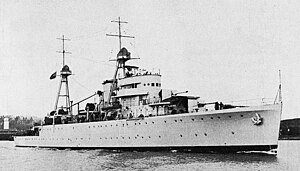
Afonso de Albuquerque, 1st Duke of Goa, was a Portuguese general, admiral, and statesman. He served as viceroy of Portuguese India from 1509 to 1515, during which he expanded Portuguese influence across the Indian Ocean and built a reputation as a fierce and skilled military commander.

The Battle of Diu was a naval battle fought on 3 February 1509 in the Arabian Sea, in the port of Diu, India, between the Portuguese Empire and a joint fleet of the Sultan of Gujarat, the Mamlûk Burji Sultanate of Egypt, and the Zamorin of Calicut with support of the Republic of Venice and the Ottoman Empire.

INS Delhi was a Leander-class light cruiser built for the Royal Navy in 1933 as HMS Achilles, and commissioned into the New Zealand Division of the Royal Navy in 1937 as HMNZS Achilles. She was returned to the Royal Navy at the end of the Second World War and in 1948 was sold to the Royal Indian Navy to be recommissioned as HMIS Delhi. In 1950 she was renamed INS Delhi and remained in service until decommissioned at Bombay on 30 June 1978.

Maritime powers in the Indian subcontinent have possessed navies for many centuries. Indian dynasties such as the Cholas used naval power to extend their influence overseas, particularly to Southeast Asia. The Marakkar Navy under Zamorins during 15th century and the Maratha Navy of the 17th and 18th centuries fought with rival Indian powers and European trading companies. The East India Company organised its own navy, which came to be known as the Bombay Marine. With the establishment of the British Raj after the Indian Rebellion of 1857, the small navy was transformed into "His Majesty's Indian Navy", then "Her Majesty's Indian Marine", and finally the "Royal Indian Marine".

The Portuguese Navy is the naval branch of the Portuguese Armed Forces which, in cooperation and integrated with the other branches of the Portuguese military, is charged with the military defense of Portugal.
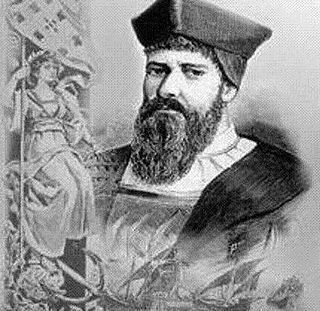
João da Nova was a Galician-born explorer in the service of Portugal. He is credited as the discoverer of Ascension and Saint Helena islands.

HMS Dalrymple was a Bay-class anti-aircraft frigate of the British Royal Navy, which served as a survey ship, mostly in the Persian Gulf, from 1948 until 1965. She was completed to deal with the large numbers of uncharted wrecks and mines around the British Isles as a result of World War II. For this purpose she was fitted for minesweeping. She was named for the pioneering Hydrographer of the Admiralty Alexander Dalrymple (1737–1808).

The Annexation of Goa was the process in which the Republic of India annexed Estado da Índia, the then Portuguese Indian territories of Goa, Daman and Diu, starting with the armed action carried out by the Indian Armed Forces in December 1961. In India, this action is referred to as the "Liberation of Goa". In Portugal, it is referred to as the "Invasion of Goa". Jawaharlal Nehru had hoped that the popular movement in Goa and the pressure of world public opinion would force the Portuguese Goan authorities to grant it independence but since it did not have any effect, he decided to take it by force.

Portuguese maritime exploration resulted in the numerous territories and maritime routes recorded by the Portuguese as a result of their intensive maritime journeys during the 15th and 16th centuries. Portuguese sailors were at the vanguard of European exploration, chronicling and mapping the coasts of Africa and Asia, then known as the East Indies, and Canada and Brazil, in what came to be known as the Age of Discovery.
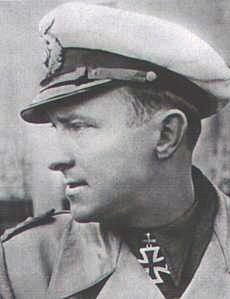
Robert Karl Friedrich Gysae was a German U-boat commander in the Kriegsmarine during World War II. He was a recipient of the Knight's Cross of the Iron Cross with Oak Leaves of Nazi Germany. Gysae commanded U-98 and U-177, being credited with sinking twenty-five ships on eight patrols, for a total of 146,815 gross register tons (GRT) of Allied shipping.

INS Betwa (F39) is a Brahmaputra-class guided missile frigate currently in service with the Indian Navy. The ship is named for the Betwa River.

Anjediva Island is an Indian island in the Arabian Sea. It sits off the coast of Canacona, Goa. It is politically part of Goa state, geographically the nearest mainland is the coastal Kanara subregion of Carnataca.

Flor do Mar or Flor de la Mar, spelled Frol de la Mar in all Portuguese chronicles of the 16th century, was a Portuguese nau (carrack) of 400 tons, which over nine years participated in decisive events in the Indian Ocean until her sinking in November 1511. Nobleman Afonso de Albuquerque was returning from the conquest of Malacca, bringing with him a large treasure trove for the Portuguese king, when the ship was lost off the coast of Sumatra. A replica of Flor do Mar is housed in the Maritime Museum in Malacca, Malaysia.

The Portuguese conquest of Goa occurred when the governor Afonso de Albuquerque captured the city in 1510 from the Adil Shahis. Goa became the capital of the Portuguese State of India which included possessions such as Fort Manuel, the territory of Bom Bahia, Daman and Chaul. It was not among the places Albuquerque was supposed to conquer. He did so after he was offered the support and guidance of Timoji and his troops. Albuquerque had been given orders by Manuel I of Portugal to capture Ormus, Aden and Malacca only. Goa would remain under Portuguese control until 1961.

Dom Fernando II e Glória is a wooden-hulled, 50-gun frigate of the Portuguese Navy. She was launched in 1843 and made her maiden voyage in 1845. Built at the shipyard of Daman in Portuguese India, it was Portugal's last sailing warship to be built and also the last ship that undertook the Carreira da Índia, a regular military line that connected Portugal to its colonies in India since the beginning of the 16th century.
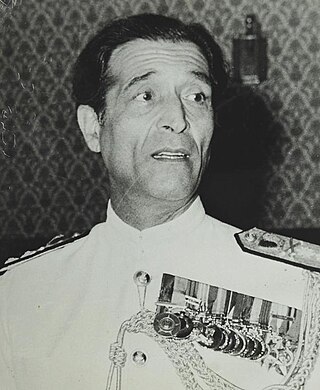
Vice Admiral Rustom Khushro Shapur 'Rusi' Ghandhi, PVSM, VrC was a former flag officer in the Indian Navy. He last served as the Flag Officer Commanding-in-Chief Western Naval Command from 1977 to 1979. He is the only officer to have commanded ships in all wars and conflicts post Independence. He commanded the frigate INS Betwa (1959) during the Annexation of Goa, the destroyer INS Khukri (F149) during the Indo-Pakistani War of 1965 and the cruiser INS Mysore (C60) during the Indo-Pakistani War of 1971.

RMS Nova Scotia was a 6,796 GRT UK transatlantic ocean liner and Royal Mail Ship. In World War II she was requisitioned as a troopship. In 1942 a German submarine sank her in the Indian Ocean with the loss of 858 of the 1,052 people aboard.

The 1936 Naval Revolt or Tagus boats mutiny was a mutiny in Portugal that occurred on 8 September 1936 aboard the aviso Afonso de Albuquerque and destroyer Dão. It was organized by the Revolutionary Organization of the Fleet, a left-wing group with links to the Portuguese Communist Party.
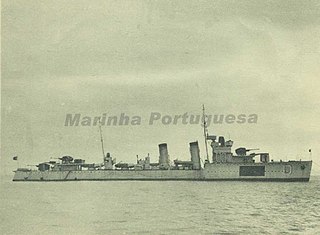
NRP Dão was one of five Douro-class destroyer built for the Portuguese Navy during the 1930s. She remained in service until 1960, being refitted and re-armed several times and taking place in a coup attempt in 1936.
